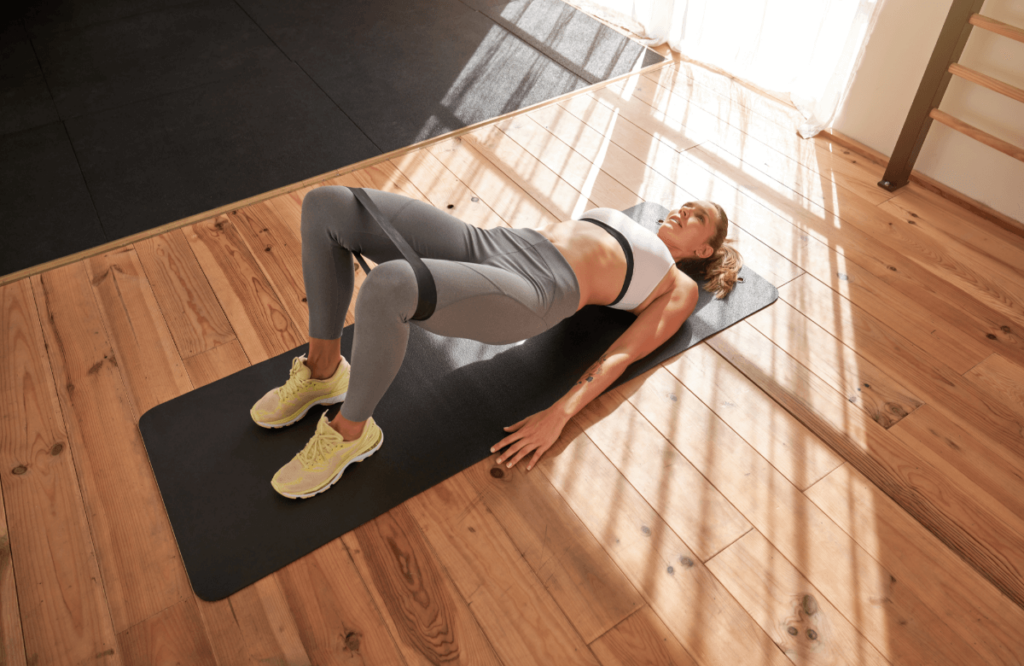Building strong and shapely glutes is a fitness goal shared by many, and achieving it requires a well-rounded approach that includes targeted exercises. Two of the most effective and popular options for developing the gluteal muscles are the glute bridge and the hip thrust. Despite their visual similarities, these exercises have distinct differences that cater to different fitness goals and preferences. In this comprehensive article, we’ll delve deep into the differences between the glute bridge and the hip thrust, explore their unique benefits, provide detailed instructions on how to perform each exercise correctly, and help you decide which one aligns better with your fitness objectives.
Jump to:
- What Is Hip Thrust?
- What Are Glute Bridges?
- Glute Bridge vs. Hip Thrust
- Muscles Worked
- Glute Activation
- Comfort (of External Load on Hips)
- Difficulty Level
- Ability to Add Load
- Equipment Needed
- Benefits of Glute Bridges
- Benefits of Hip Thrusts
- How to Do Glute Bridges
- How to Do Hip Thrusts
- Which One Should You Choose?
What Is Hip Thrust?
The hip thrust, conceptualized and popularized by renowned strength coach Bret Contreras, is a compound lower body exercise that specifically targets the gluteus maximus, the largest muscle in the buttocks. It has become a staple in many strength and conditioning programs due to its effectiveness in building strong, toned glutes. The hip thrust involves lifting the hips off the ground while maintaining a stable base with the feet planted firmly on the floor. This action creates a bridge-like position with the body, making it an excellent choice for glute development.
What Are Glute Bridges?
Glute bridges, while similar in concept to hip thrusts, offer a slightly different approach to targeting the glutes. In this exercise, you begin by lying flat on your back with your knees bent and feet flat on the floor. By pressing through your heels and engaging your glutes, you lift your hips toward the ceiling, creating a bridge shape with your body. Glute bridges are a fantastic way to activate and strengthen the gluteal muscles, making them an excellent choice for individuals of varying fitness levels.
Glute Bridge vs. Hip Thrust
Now, let’s take a closer look at the key differences between these two exercises.
Muscles Worked
Hip Thrust: This exercise primarily targets the gluteus maximus, with some additional activation of the hamstrings.
Glute Bridge: While also targeting the gluteus maximus, the glute bridge places slightly more emphasis on the lower back muscles.
Glute Activation
Hip Thrust: The hip thrust provides a more extensive range of motion compared to the glute bridge, leading to more intense glute activation.
Glute Bridge: While still effective, the glute bridge offers a slightly less extensive range of motion, resulting in slightly less glute activation when compared to the hip thrust.
Comfort (of External Load on Hips)
Hip Thrust: The hip thrust is generally more comfortable when incorporating added weight, such as a barbell or dumbbell.
Glute Bridge: The positioning of the load during glute bridges may be less comfortable for some individuals, particularly when heavier weights are involved.
Difficulty Level
Hip Thrust: As a result of its greater range of motion and potential for heavier weights, the hip thrust is often considered more challenging.
Glute Bridge: Glute bridges are generally perceived as an easier exercise, making them suitable for beginners and those looking to gradually progress.
Ability to Add Load
Hip Thrust: The hip thrust easily accommodates progressive overload by increasing the weight, making it an excellent choice for those seeking continuous growth and strength gains.
Glute Bridge: While you can add weight to glute bridges, it may be less practical with very heavy loads due to the positioning of the weight.
Equipment Needed
Hip Thrust: Performing hip thrusts often requires access to a bench or a stable surface to support your upper back and a barbell or other weights for resistance.
Glute Bridge: Glute bridges are more accessible for home workouts as they require minimal equipment, typically only a mat or a soft surface.
Benefits of Glute Bridges
- Suitable for beginners due to their simplicity and lower difficulty level.
- Highly effective for glute activation and strengthening, particularly for those just starting to work on their glutes.
- Ideal for individuals with lower back issues as they place less stress on the lower back compared to hip thrusts.
- Convenient for warm-up routines or as a supplementary exercise in your workout regimen.
- Can be performed virtually anywhere with minimal equipment and can be modified for a higher difficulty level.

Benefits of Hip Thrusts
- Highly effective for building and shaping the glutes, making them an excellent choice for those seeking noticeable results.
- Offers substantial potential for progressive overload, allowing for continuous strength and muscle growth.
- Enhances hip extension and overall lower body power, making it beneficial for athletes and fitness enthusiasts.
- Ideal for advanced lifters looking to target the glutes intensely and achieve a well-defined posterior chain.
- Suitable for those who have access to gym equipment, such as barbells and weight plates.
How to Do Glute Bridges
- Lie on your back with your knees bent at a 90-degree angle and your feet flat on the floor, hip-width apart.
- Place your arms at your sides with your palms facing down.
- Press through your heels to lift your hips off the ground, keeping your upper back and shoulders on the floor.
- Squeeze your glutes at the top of the movement.
- Lower your hips back down to the starting position.
- Repeat for the desired number of repetitions.
How to Do Hip Thrusts
- Sit on the floor with your upper back leaning against a bench or a stable surface.
- Place a barbell or weight plate over your hips, securing it in place.
- Roll the barbell or weight plate over your hips until it is positioned comfortably.
- Plant your feet firmly on the ground, shoulder-width apart.
- Lift your hips off the ground until your thighs and upper body are parallel to the floor, maintaining a stable base.
- Squeeze your glutes forcefully at the top of the movement.
- Lower your hips back down to the starting position, ensuring controlled motion.
- Repeat for the desired number of repetitions.

Which One Should You Choose?
The decision between glute bridges and hip thrusts hinges on your specific fitness goals, experience level, and available equipment. Here’s a summary to help guide your choice:
- If you’re a beginner or seeking a simpler exercise to activate and strengthen your glutes, glute bridges are an excellent starting point.
- Glute bridges are also a suitable option if you have lower back issues, as they place less stress on the lower back.
- For those looking to achieve more intense glute activation, noticeable results, and who have access to gym equipment, hip thrusts are the preferred choice.
- Hip thrusts are ideal for advanced lifters aiming to target the glutes intensely and sculpt a well-defined posterior chain.
It’s worth noting that incorporating both exercises into your lower body workout routine can provide a well-rounded approach to building stronger and more defined glutes. Remember, consistency and proper form are paramount to achieving your desired results, regardless of which exercise you choose. So, select the one that aligns with your goals, stay dedicated to your training regimen, and enjoy the benefits of a sculpted posterior chain that goes beyond aesthetics, improving overall lower body strength and functionality.














